Cite this document
(The Welfare State: Britains Rise to Social Freedom Essay, n.d.)
The Welfare State: Britains Rise to Social Freedom Essay. https://studentshare.org/sociology/1767422-outline-the-key-reasons-for-the-development-of-the-welfare-state-in-1945-what-was-the-welfare-state-intended-to-combat-and-how-successful-was-it
The Welfare State: Britains Rise to Social Freedom Essay. https://studentshare.org/sociology/1767422-outline-the-key-reasons-for-the-development-of-the-welfare-state-in-1945-what-was-the-welfare-state-intended-to-combat-and-how-successful-was-it
(The Welfare State: Britains Rise to Social Freedom Essay)
The Welfare State: Britains Rise to Social Freedom Essay. https://studentshare.org/sociology/1767422-outline-the-key-reasons-for-the-development-of-the-welfare-state-in-1945-what-was-the-welfare-state-intended-to-combat-and-how-successful-was-it.
The Welfare State: Britains Rise to Social Freedom Essay. https://studentshare.org/sociology/1767422-outline-the-key-reasons-for-the-development-of-the-welfare-state-in-1945-what-was-the-welfare-state-intended-to-combat-and-how-successful-was-it.
“The Welfare State: Britains Rise to Social Freedom Essay”. https://studentshare.org/sociology/1767422-outline-the-key-reasons-for-the-development-of-the-welfare-state-in-1945-what-was-the-welfare-state-intended-to-combat-and-how-successful-was-it.


